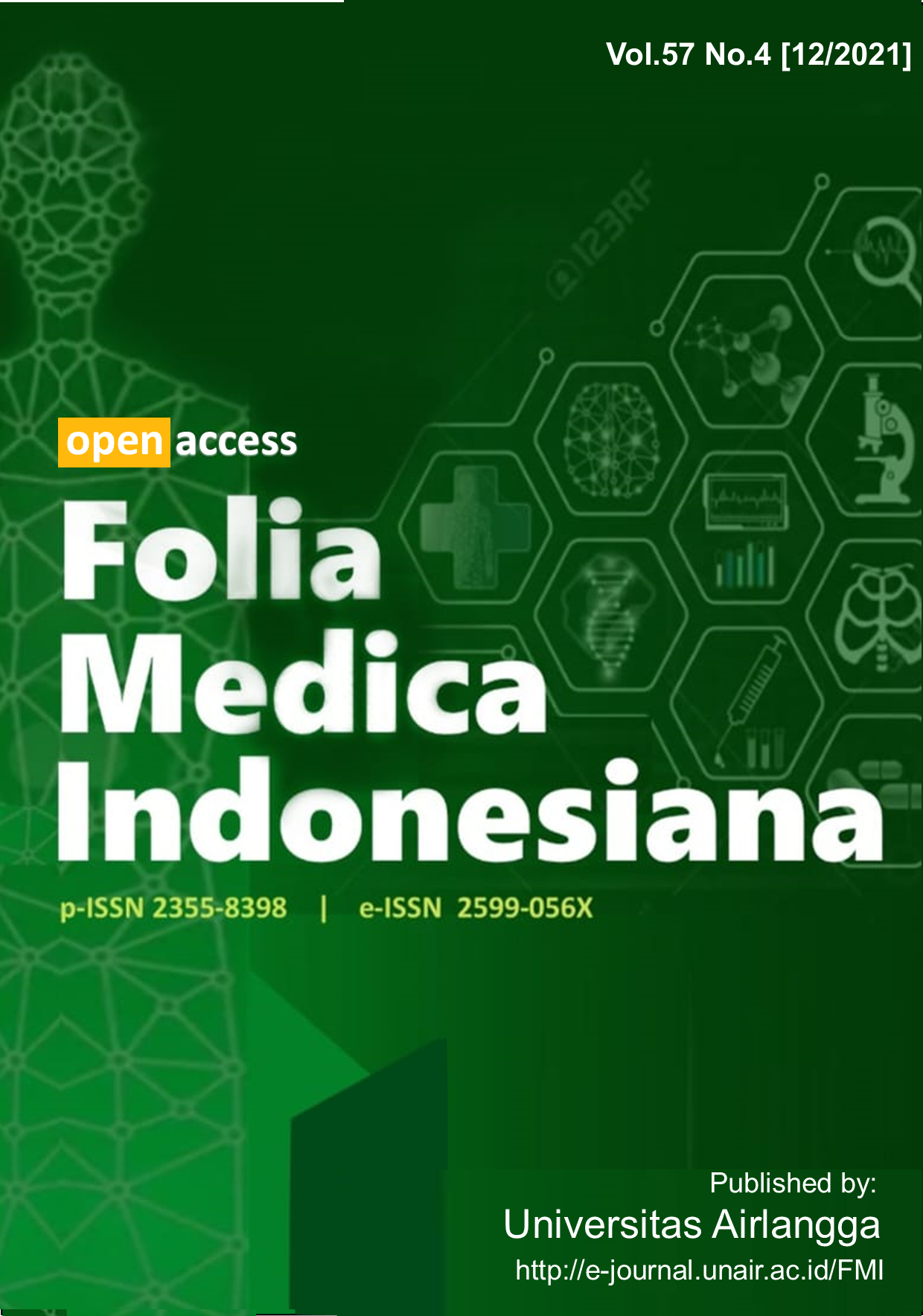Main Article Content
Abstract
Highlight:
- A young adult has activity-triggered atypical chest pain and diagnosed malignant RCA.
- Congenital anomalies needed to be aware by cardiologists to help clinical practice.
- Planning a treatment about management of the CAAs condition should be undertaken by the inter-specialist team.
Abstract:
We presented a case a young adult with activity-triggered atypical chest pain and diagnosed with anomalous origin of right coronary artery (RCA) from the left coronary sinus with an interarterial course between the aorta and the main pulmonary artery that was detected by CT coronary angiography. This anomaly has been called malignant RCA. Coronary artery anomaly is a congenital condition. Most of the cases remain asymptomatic. This condition is also one of the most causes of sudden cardiac death, because the coronary artery examination is not regularly done. Nevertheless, during high intensity activity, it could be symptomatic and might be lethal. Diagnosing coronary artery anomalies might be tricky and cardiologists must be aware of this. The CAAs condition is a rare situation. The CAAs condition is associated with sudden death, especially intense physical activity. There was no rigid guideline for the management of the CAAs condition, so that planning a treatment in the inter-specialist team should be done.
Keywords
Article Details
Copyright (c) 2021 Sidhi Laksono Purwowiyoto, Steven Philip Surya

This work is licensed under a Creative Commons Attribution-NonCommercial-ShareAlike 4.0 International License.
-
Folia Medica Indonesiana is a scientific peer-reviewed article which freely available to be accessed, downloaded, and used for research purposes. Folia Medica Indonesiana (p-ISSN: 2541-1012; e-ISSN: 2528-2018) is licensed under a Creative Commons Attribution 4.0 International License. Manuscripts submitted to Folia Medica Indonesiana are published under the terms of the Creative Commons License. The terms of the license are:
Attribution ” You must give appropriate credit, provide a link to the license, and indicate if changes were made. You may do so in any reasonable manner, but not in any way that suggests the licensor endorses you or your use.
NonCommercial ” You may not use the material for commercial purposes.
ShareAlike ” If you remix, transform, or build upon the material, you must distribute your contributions under the same license as the original.
No additional restrictions ” You may not apply legal terms or technological measures that legally restrict others from doing anything the license permits.
You are free to :
Share ” copy and redistribute the material in any medium or format.
Adapt ” remix, transform, and build upon the material.

References
- Angelini P (2002). Coronary artery anomalies – current clinical issues: Definitions, classification, incidence, clinical relevance, and treatment guideline. Tex Heart I J 29, 271-278.
- Angelini P (2007). Coronary artery anomalies: An entity in search of an identity. Circulation 115, 1296-1305.
- Basso C (2005). Congenital coronary artery anomalies at risk of myocardial ischemia and sudden death. European Cardiology 1, 1-5.
- Cheitlin MD, MacGregor J (2009). Congenital anomalies of coronary arteries: role in the pathogenesis of sudden cardiac death. Herz 34, 268-279.
- Datta J, White CS, Glikeson RC, et al (2005). Anomalous coronary arteries in adults: Depiction at multi-detector row CT angiography. Radiology 235, 812-818.
- Davis JA, Cecchin F, Jones TK, (2001). Major coronary artery anomalies in a pediatric population: incidence and clinical importance. J Am Coll Cardiol 37, 593-597.
- Graidis C, Dimitriadis D, Karasavvidis V, et al (2015). Prevalence and characteristic of coronary artery anomalies in an adult population undergoing multidetector-row computed tomography for the evaluation of coronary artery disease. BMC Cardiovasc Disord 15, 1-10.
- Hill SF, Shepprad MN (2014). A silent cause of sudden cardiac death especially in sport: Congenital coronary artery anomalies. Br J Sport Med 48, 115-116.
- Lluri G, Aboulhosn J (2014). Coronary arterial development: A review of normal and congenital anomalous patterns. Clin Cardiol 37, 126-130.
- Satija B, Sanyal K, Katyani K (2012). Malignant anomalous right coronary artery detected by multidetector row computed tomography coronary angiography. J Cardiovasc Dis Res 3, 40-42.
- Silva A, Baptista MJ, Araujo E (2018). Congenital coronary artery anomalies. Rev Port Cardiol. 37, 341-350.
- Wasfy MM, Weiner RB, Wang F, et al (2015). Endurance exercise-induced cardiac remodelling: not all sports are created equal. J Am Soc Echocardiogy 28, 1434-1440.
References
Angelini P (2002). Coronary artery anomalies – current clinical issues: Definitions, classification, incidence, clinical relevance, and treatment guideline. Tex Heart I J 29, 271-278.
Angelini P (2007). Coronary artery anomalies: An entity in search of an identity. Circulation 115, 1296-1305.
Basso C (2005). Congenital coronary artery anomalies at risk of myocardial ischemia and sudden death. European Cardiology 1, 1-5.
Cheitlin MD, MacGregor J (2009). Congenital anomalies of coronary arteries: role in the pathogenesis of sudden cardiac death. Herz 34, 268-279.
Datta J, White CS, Glikeson RC, et al (2005). Anomalous coronary arteries in adults: Depiction at multi-detector row CT angiography. Radiology 235, 812-818.
Davis JA, Cecchin F, Jones TK, (2001). Major coronary artery anomalies in a pediatric population: incidence and clinical importance. J Am Coll Cardiol 37, 593-597.
Graidis C, Dimitriadis D, Karasavvidis V, et al (2015). Prevalence and characteristic of coronary artery anomalies in an adult population undergoing multidetector-row computed tomography for the evaluation of coronary artery disease. BMC Cardiovasc Disord 15, 1-10.
Hill SF, Shepprad MN (2014). A silent cause of sudden cardiac death especially in sport: Congenital coronary artery anomalies. Br J Sport Med 48, 115-116.
Lluri G, Aboulhosn J (2014). Coronary arterial development: A review of normal and congenital anomalous patterns. Clin Cardiol 37, 126-130.
Satija B, Sanyal K, Katyani K (2012). Malignant anomalous right coronary artery detected by multidetector row computed tomography coronary angiography. J Cardiovasc Dis Res 3, 40-42.
Silva A, Baptista MJ, Araujo E (2018). Congenital coronary artery anomalies. Rev Port Cardiol. 37, 341-350.
Wasfy MM, Weiner RB, Wang F, et al (2015). Endurance exercise-induced cardiac remodelling: not all sports are created equal. J Am Soc Echocardiogy 28, 1434-1440.

